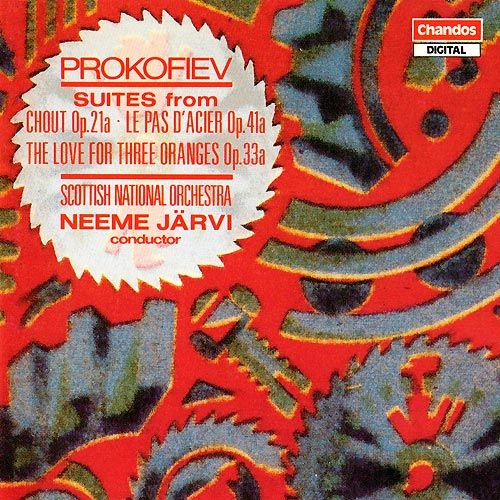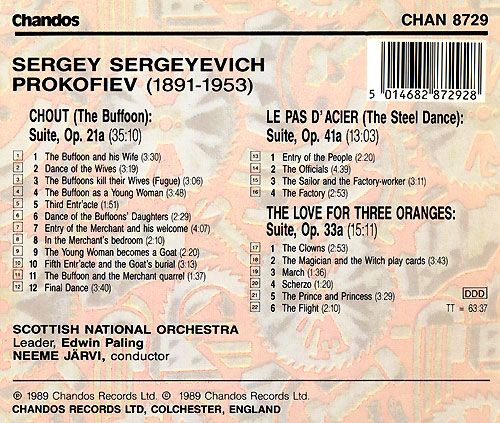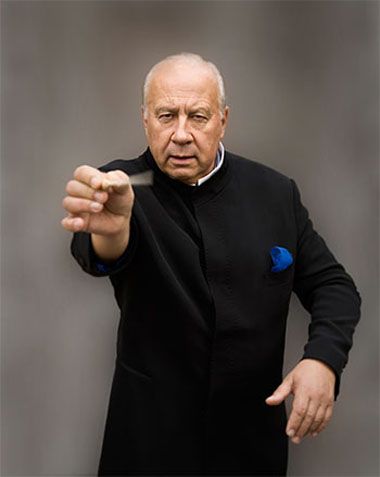wimpel69
11-25-2014, 02:12 PM
EAC-FLAC link below. This is my own rip. Complete artwork,
LOG and CUE files included. Do not share. Buy the original!
Please leave a "Like" or "Thank you" if you enjoyed this!
Sergei Prokofiev wrote Chout (The Buffoon) in 1915, but revised it in 1920 for the May 17,
Paris premiere, the following year, by Sergei Diagilev's Ballet Russes. The composer conducted, and its first
performances were generally successful, though the somewhat unimaginative choreography by Larionov
and Slavinsky eventually proved its undoing.
The ballet consists of six scenes, each separated by an entr'acte, thus tallying eleven numbers in all.
The suite that Prokofiev extracted in 1922 contains twelve movements but is not an expansion of the
score: a concert performance typically lasts about thirty-five to forty minutes, while the full ballet score
takes nearly an hour. In arranging The Buffoon Suite Prokofiev eliminated some music from the ballet
altogether. For example, the first entr'acte and a grotesque but highly effective rhythmic episode mainly
for brass and percussion from Scene Three do not appear in the Suite. And only small slices of certain
other sections are used.
But the reason Prokofiev fashioned more movements in the Suite than appear in the original score was
that he divided certain dances into as many as four parts. The ballet's Scene Six - In The Merchant's
Garden, for instance, is the source music for the last four movements in the Suite.
The Suite's first movement, The Buffoon and his Wife opens with some leaping, glissando-like figures
that are followed by the dominant main theme, played on oboe. It is a curious melody, at once comical
and mournful, depicting the image of a sad clown and perfectly appropriate for the story's chief buffoon.
Early in the ballet, he will induce seven other buffoons to kill their wives after he pretends to raise his
wife from the dead with a magic whip. The second movement, Dance of the Wives is oafishly comical
at the outset, then turns suavely Russian in the latter half with a cleverly orchestrated, quite memorable
lively melody.
The Buffoons kill their wives follows. It is boisterous and fantasy-like in the first half, then becomes
mostly subdued in the latter part. The fourth movement is The Buffoon as a Young Woman, which
contains perhaps the most subtle thematic creation in the entire work. The theme has an arch-like
pattern and imparts a surreal atmosphere. The latter half of this sequence turns tense and angry,
but never leaves its netherworld.
The brief Third Entr'acte follows, using the main theme, then livelier music for the latter part.
Dance of the Buffoons' Daughters brings music of a Russian character and more than vaguely sounds
like drunken Tchaikovsky, though the fast music that follows alludes to no outside influence. The
Entry of the Merchant and his welcome begins ominously, the lower brass warning of some great doom.
But the ethereal world returns with both spookiness and sadness and some interesting variations on
the main theme.
The eighth movement, In the Merchant's Bedroom introduces the same theme that appears the next
section, The Young Woman becomes a Goat. In the former, the music is slow and serene, while in
the latter it is big and pompous, quite appropriate for a scene of great spectacle. Here, the music's
purpose is satire and mockery. The Fifth Entr'acte and the Goat's Burial is subdued and recalls
several previous themes.
The last two movements, The Buffoon and the Merchant quarrel and Final Dance contain some
of the finest music in the ballet. The former is powerful and driven, and reaches a shattering climax.
The latter begins slowly and works its joyous and ecstatic theme into a rousing and glorious finish.
Le pas d'acier (The Steel Dance) was Prokofiev's second ballet for Sergei Diaghilev and his
Ballets Russes. It scored a success at its 1927 Paris premiere, and Prokofiev, as was his wont,
immediately fashioned a suite from the work. In a sense, his efforts were a bit puzzling -- the
ballet itself only lasts about a half hour and hardly needs condensing. Nevertheless, he undertook
the project and managed to successfully combine some of the better numbers into one movement
here and to give cohesion to music that in the ballet sometimes sounds diffuse.
The suite consists of four movements, whereas the ballet had 11 dance numbers spanning just
two scenes. The first movement in the suite, "Entry of the People," uses music from the opening
number in the ballet, "Appearance of the Participants," and features the springy, march-like
main theme. The ensuing section, "The Officials," incorporates music from the ballet's second
dance number, "The Procession of the Burghers" and its third, "Commissars." After the
moderately-paced opening, the music in "The Officials" turns energetic and colorful, as
Prokofiev's orchestration shows his instrumental mastery. This is probably the suite's finest
movement.
The third section, "The Sailor and the Factory Worker," is virtually the same as No. 6 in the
ballet, "The Sailor and the Girl Worker." The music is lyrical and rather delicate, though
there is much instrumental color and playfulness in the orchestral writing in the opening
section. The last movement here, "The Factory," incorporates music from the ballet's No. 9,
"Factory," and No. 11, "Closing Scene." The suite's finale is mechanical-sounding, with
pounding rhythms and a grand, colorful climax, where the march-like main theme from
the first section returns for a triumphal finish.

Music Composed by
Sergei Prokofiev
Played by the
Royal Scottish National Orchestra
Conducted by
Neeme J�rvi

"The Jarvi/Prokofiev connection more or less speaks for itself now, and is it my imagination
or do the SNO sound more like native Slavs with each disc? The two Diaghilev ballets from Prokofiev's
exile years are more than adequately represented here in their suite form, streaks of brilliance
offsetting pages of the merely mediocre.
Needless to say, Jarvi makes no such apology, seeing to it that even the thinnest pages of a
sporadically entertaining work like Chout are given the very highest profile: here then are
elements of burleske as typified by the loud-mouthed clarinet of the opening number, the sensual
decadence of ''the Buffoon disguised as his sister'' with its curvacious insinuating harmonies�
Jarvi and his strings enjoy that�and the rich Merchant's sweeping folk melody decked out in
opulent string and horn unison, later returning over a welter of pulsating percussion. All are
duly relished, none more so than the undoubted highspot of the suite�the demented Final
Dance, which builds from lone folksy fiddler to full orchestral frenzy in little more than three
minutes. Jarvi turns whirling dervish with a vengeance during the final pages, but somehow
manages to keep his balance long enough to deliver a wonderfully decisive pay-off in the
last couple of bars.
From Chout, with barely pause for breath, we are into the iron and steel foundry with Le pas
d'acier, its tireless ostinatos and mechanical percussion (explicit to the last cog and wheel
in the final movement�''The factory''�and again most excitingly executed) pausing only for
a little light relief in the third of the four movements where a well-soused sailor (bassoon) is
persuaded by a woman worker to join the factory force (gently persuasive violin, what else?).
Significant, if not vintage Prokofiev, then, and a must for the library shelf however
infrequently one might take it down.
On more familiar ground, the clatter of trumpets and side drum and terrific braying horns
immediately signal that Jarvi's Three oranges suite will be everything one might expect.
The great skirls of strings and upper winds create a dazzling effect in the card-game
between Magician and Witch, we've an unusually gritty ''March'' and furious ''Flight''
(the SNO strings once again delivering above and beyond the call of duty) where the
stern warnings of tam-tam, bass drum and heavy brass once again put our equipment
through its paces.'"
Edward Seckerson, Gramophone

Download Link - https://mega.co.nz/#!eFpRiI6b!R87LOz7vjxPPTPQKjeVG92Q9vNLm9fOWtLljFo1 jVmg
Source: Chandos Records CD, 1989 (my rip!)
Format: FLAC(RAR), DDD Stereo, Level: -5
File Size: 331 MB (incl. artwork, booklet, log & cue)
Enjoy! Don't share! Buy the origina! Please leave a "Like" or "Thank you" if you enjoyed this! :)
LOG and CUE files included. Do not share. Buy the original!
Please leave a "Like" or "Thank you" if you enjoyed this!
Sergei Prokofiev wrote Chout (The Buffoon) in 1915, but revised it in 1920 for the May 17,
Paris premiere, the following year, by Sergei Diagilev's Ballet Russes. The composer conducted, and its first
performances were generally successful, though the somewhat unimaginative choreography by Larionov
and Slavinsky eventually proved its undoing.
The ballet consists of six scenes, each separated by an entr'acte, thus tallying eleven numbers in all.
The suite that Prokofiev extracted in 1922 contains twelve movements but is not an expansion of the
score: a concert performance typically lasts about thirty-five to forty minutes, while the full ballet score
takes nearly an hour. In arranging The Buffoon Suite Prokofiev eliminated some music from the ballet
altogether. For example, the first entr'acte and a grotesque but highly effective rhythmic episode mainly
for brass and percussion from Scene Three do not appear in the Suite. And only small slices of certain
other sections are used.
But the reason Prokofiev fashioned more movements in the Suite than appear in the original score was
that he divided certain dances into as many as four parts. The ballet's Scene Six - In The Merchant's
Garden, for instance, is the source music for the last four movements in the Suite.
The Suite's first movement, The Buffoon and his Wife opens with some leaping, glissando-like figures
that are followed by the dominant main theme, played on oboe. It is a curious melody, at once comical
and mournful, depicting the image of a sad clown and perfectly appropriate for the story's chief buffoon.
Early in the ballet, he will induce seven other buffoons to kill their wives after he pretends to raise his
wife from the dead with a magic whip. The second movement, Dance of the Wives is oafishly comical
at the outset, then turns suavely Russian in the latter half with a cleverly orchestrated, quite memorable
lively melody.
The Buffoons kill their wives follows. It is boisterous and fantasy-like in the first half, then becomes
mostly subdued in the latter part. The fourth movement is The Buffoon as a Young Woman, which
contains perhaps the most subtle thematic creation in the entire work. The theme has an arch-like
pattern and imparts a surreal atmosphere. The latter half of this sequence turns tense and angry,
but never leaves its netherworld.
The brief Third Entr'acte follows, using the main theme, then livelier music for the latter part.
Dance of the Buffoons' Daughters brings music of a Russian character and more than vaguely sounds
like drunken Tchaikovsky, though the fast music that follows alludes to no outside influence. The
Entry of the Merchant and his welcome begins ominously, the lower brass warning of some great doom.
But the ethereal world returns with both spookiness and sadness and some interesting variations on
the main theme.
The eighth movement, In the Merchant's Bedroom introduces the same theme that appears the next
section, The Young Woman becomes a Goat. In the former, the music is slow and serene, while in
the latter it is big and pompous, quite appropriate for a scene of great spectacle. Here, the music's
purpose is satire and mockery. The Fifth Entr'acte and the Goat's Burial is subdued and recalls
several previous themes.
The last two movements, The Buffoon and the Merchant quarrel and Final Dance contain some
of the finest music in the ballet. The former is powerful and driven, and reaches a shattering climax.
The latter begins slowly and works its joyous and ecstatic theme into a rousing and glorious finish.
Le pas d'acier (The Steel Dance) was Prokofiev's second ballet for Sergei Diaghilev and his
Ballets Russes. It scored a success at its 1927 Paris premiere, and Prokofiev, as was his wont,
immediately fashioned a suite from the work. In a sense, his efforts were a bit puzzling -- the
ballet itself only lasts about a half hour and hardly needs condensing. Nevertheless, he undertook
the project and managed to successfully combine some of the better numbers into one movement
here and to give cohesion to music that in the ballet sometimes sounds diffuse.
The suite consists of four movements, whereas the ballet had 11 dance numbers spanning just
two scenes. The first movement in the suite, "Entry of the People," uses music from the opening
number in the ballet, "Appearance of the Participants," and features the springy, march-like
main theme. The ensuing section, "The Officials," incorporates music from the ballet's second
dance number, "The Procession of the Burghers" and its third, "Commissars." After the
moderately-paced opening, the music in "The Officials" turns energetic and colorful, as
Prokofiev's orchestration shows his instrumental mastery. This is probably the suite's finest
movement.
The third section, "The Sailor and the Factory Worker," is virtually the same as No. 6 in the
ballet, "The Sailor and the Girl Worker." The music is lyrical and rather delicate, though
there is much instrumental color and playfulness in the orchestral writing in the opening
section. The last movement here, "The Factory," incorporates music from the ballet's No. 9,
"Factory," and No. 11, "Closing Scene." The suite's finale is mechanical-sounding, with
pounding rhythms and a grand, colorful climax, where the march-like main theme from
the first section returns for a triumphal finish.

Music Composed by
Sergei Prokofiev
Played by the
Royal Scottish National Orchestra
Conducted by
Neeme J�rvi

"The Jarvi/Prokofiev connection more or less speaks for itself now, and is it my imagination
or do the SNO sound more like native Slavs with each disc? The two Diaghilev ballets from Prokofiev's
exile years are more than adequately represented here in their suite form, streaks of brilliance
offsetting pages of the merely mediocre.
Needless to say, Jarvi makes no such apology, seeing to it that even the thinnest pages of a
sporadically entertaining work like Chout are given the very highest profile: here then are
elements of burleske as typified by the loud-mouthed clarinet of the opening number, the sensual
decadence of ''the Buffoon disguised as his sister'' with its curvacious insinuating harmonies�
Jarvi and his strings enjoy that�and the rich Merchant's sweeping folk melody decked out in
opulent string and horn unison, later returning over a welter of pulsating percussion. All are
duly relished, none more so than the undoubted highspot of the suite�the demented Final
Dance, which builds from lone folksy fiddler to full orchestral frenzy in little more than three
minutes. Jarvi turns whirling dervish with a vengeance during the final pages, but somehow
manages to keep his balance long enough to deliver a wonderfully decisive pay-off in the
last couple of bars.
From Chout, with barely pause for breath, we are into the iron and steel foundry with Le pas
d'acier, its tireless ostinatos and mechanical percussion (explicit to the last cog and wheel
in the final movement�''The factory''�and again most excitingly executed) pausing only for
a little light relief in the third of the four movements where a well-soused sailor (bassoon) is
persuaded by a woman worker to join the factory force (gently persuasive violin, what else?).
Significant, if not vintage Prokofiev, then, and a must for the library shelf however
infrequently one might take it down.
On more familiar ground, the clatter of trumpets and side drum and terrific braying horns
immediately signal that Jarvi's Three oranges suite will be everything one might expect.
The great skirls of strings and upper winds create a dazzling effect in the card-game
between Magician and Witch, we've an unusually gritty ''March'' and furious ''Flight''
(the SNO strings once again delivering above and beyond the call of duty) where the
stern warnings of tam-tam, bass drum and heavy brass once again put our equipment
through its paces.'"
Edward Seckerson, Gramophone

Download Link - https://mega.co.nz/#!eFpRiI6b!R87LOz7vjxPPTPQKjeVG92Q9vNLm9fOWtLljFo1 jVmg
Source: Chandos Records CD, 1989 (my rip!)
Format: FLAC(RAR), DDD Stereo, Level: -5
File Size: 331 MB (incl. artwork, booklet, log & cue)
Enjoy! Don't share! Buy the origina! Please leave a "Like" or "Thank you" if you enjoyed this! :)